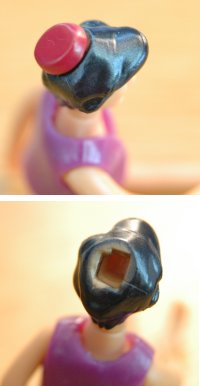If you have a young daughter, you’ve probably run across the Polly Pocket phenomenon by now. But, in case you haven’t, Polly Pockets are small dolls, a couple of inches tall, that come with rubbery plastic clothes, shoes, hats, and other sundries. Little girls seem love them; they’re very popular. My four-year-old daughter first saw them when she was three, at someone else’s house; she was instantly hooked. She’s rarely, if ever, exposed to commercial television, so she didn’t get taken in by overt marketing; something about the small dolls and their tiny clothes just instantly appealed to her. We now have our own growing collection of Polly Pockets; she’ll sometimes spend an hour or more playing with them, changing their outfits, putting them here, putting them there–she loves them. My niece, who’s several years older than my daughter, happened to be visiting one day; upon seeing the Polly Pockets, she too, was hooked immediately. Talk about your inadvertent, but nearly perfect, viral marketing.
As plastic toys go, they’re kind of cute. And they promote play that doesn’t involve television. We’re all for that. Naturally, the marketing hordes at Disney couldn’t possibly fail to latch onto something this popular, especially if the concept could be shoehorned into their annoying and ubiquitous Disney Princess line of merchandise.
So, I wasn’t really surprised to see Disney Princess-branded Polly Pocket knock-offs suddenly appear in various stores. The Disney Princess dolls are similar to the “real thing,” but the Disney designers had a few extra kinks to work out. The designers of the modern-styled Polly Pockets aren’t constrained in the clothes their dolls can wear. Disney’s designers aren’t so lucky; some of the Disney Princess characters have these narrow-waisted medieval gowns. The dolls’ heads won’t fit through the narrow waists, and it’s nearly impossible to shove the doll into the dress feet-first. Disney’s Macabre Solution? Take the doll’s head off–which does make it easier to dress the doll–then replace the head when the doll is dressed.

Explain that one to your three-year-old.
As if that weren’t Brothers Grimm enough, the Aladdin doll takes the Macabre Solution a step further. The Aladdin doll comes with two fezzes. Apparently, the designers had difficulty figuring out how to keep Aladdin’s small fezzes on his head, so they opted for a brute force solution. Each fez has a peg molded to it; viewed from the side, it looks a little like a thumb tack. And, as you can see from the photos, Aladdin’s head has a big hole in the crown. Aladdin’s fezzes are really just spikes driven straight into his parietal lobes.
Disney is one creepy behemoth.